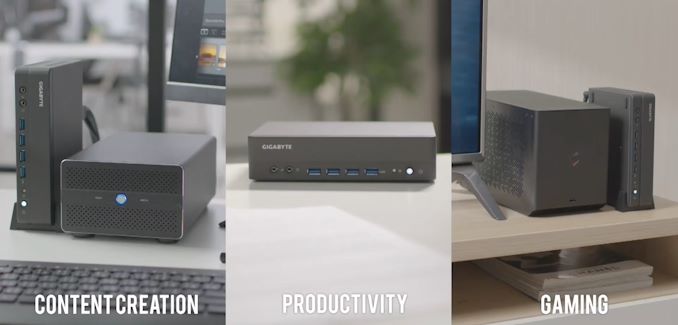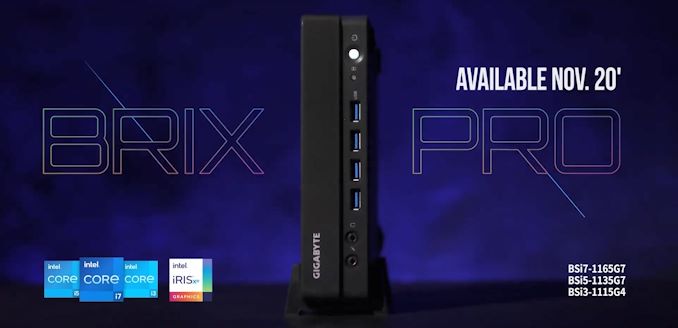GIGABYTE Unveils BRIX PRO Mini-PCs with Tiger Lake-U
by Ganesh T S on September 29, 2020 9:30 PM EST
Intel's Tiger Lake launch was focused on ultrabooks and notebooks, as various SKUs with TDP ranging from 7 to 28W were launched. The performance of Intel's low-power parts (U- and Y-series) have been good enough to land them inside small and ultra-compact form-factor systems. These systems have become a big hit in the market (not least, Intel's own NUC systems) since they gained prominence in the early 2010s. Vendors such as ASRock, ASUS, ECS, and GIGABYTE also jumped on this bandwagon to market 'NUCs' under their own branding. GIGABYTE was one of the early ones to do so with their BRIX series of mini-PCs. These SFF and UCFF systems find applications in multiple areas including content creation, productivity, and gaming, as well as embedded systems applications such as digital signage.
Intel's Tiger Lake-based NUCs (Panther Canyon and Phantom Canyon) are an open secret in tech circles. ASRock Industrial's Tiger Lake NUCs such as the NUC BOX-1165G7 have also been hinted at in Intel's marketplace - a retail follow-up to the embedded market-focused iBOX 1100 and NUC 1100 solutions. GIGABYTE, however, became the first vendor to officially announce Tiger Lake-based mini-PCs targeting the retail market with the launch of the GIGABYTE BRIX PRO. Three models (BSi3-1115G4, BSi5-1135G7, and the BSi7-1165G7) are being introduced. Their specifications are summarized in the table below.
| GIGABYTE BRIX PRO (Tiger Lake-U) Lineup | ||||
| Model | BSi3-1115G4 | BSi5-1135G7 | BSi7-1165G7 | |
| CPU | Intel Core i3-1115G4 2C/4T 1.7 - 4.1 GHz (3.0 GHz) 12 - 28 W (28W) |
Intel Core i5-1135G7 4C/8T 0.9 - 4.2 GHz (2.4 GHz) 12 - 28 W (28W) |
Intel Core i7-1165G7 4C/8T 1.2 - 4.7 GHz (2.8 GHz) 12 - 28 W (28W) |
|
| GPU | Intel® UHD Graphics for 11th Gen Intel® Processors (48EU) @ 1.25 GHz | Intel® Iris® Xe Graphics (80EU) @ 1.3 GHz | Intel® Iris® Xe Graphics (96EU) @ 1.3 GHz | |
| DRAM | Two DDR4 SO-DIMM slots Up to 64 GB of DDR4-3200 in dual-channel mode |
|||
| Motherboard | 3.5" SBC | |||
| Storage | SSD | 1x M.2-2280 (PCIe 4.0 x4 (CPU-direct)) 1x M.2-2280 (PCIe 3.0 x4 or SATA) |
||
| DFF | 1 × SATA III Port (for SATA DOM? No space for 2.5-inch drive?) | |||
| Wireless | Intel Wi-Fi 6 AX201 2x2 802.11ax Wi-Fi + Bluetooth 5.1 module |
|||
| Ethernet | 1 × GbE port (Intel I219-V) 1 × 2.5 GbE port (Intel I225-V) |
|||
| USB | Front | 4 × USB 3.2 Gen 2 Type-A | ||
| Rear | 2 × USB 3.2 Gen 2 Type-A | |||
| Thunderbolt | 1 x Thunderbolt 4 (Type-C Rear Panel) | |||
| Display Outputs | 4 × HDMI 2.0a 1 × DisplayPort 1.4 (using Thunderbolt 4 Type-C) (Only four simultaneous display outputs are supported) |
|||
| Audio | 1 × 3.5mm audio jack (Realtek ALC255) | |||
| PSU | External (135W) | |||
| Warranty | Typical, varies by country | |||
| Dimensions | Length: 196.2 mm Width: 140 mm Height: 44.4 mm |
|||
| MSRP | ? | ? | ? | |
THe Tiger Lake-based BRIX PRO eschews the NUC form-factor (approx. 4"x4" / 100mm x 100mm) for a 3.5" single-board computer one that is popular in embedded markets. The motherboard's actual dimensions are 5.75" x 4" (146mm x 102mm), and the system's dimensions come in at 196.2mm x 44.4mm x 140mm. At 1.16L in volume, it is still a compact machine. The Tiger Lake-U processors in the BRIX PRO units are configured to run at their maximum cTDPup of 28W.
One of the unique aspects of the units is the availability of 4x HDMI 2.0 ports - each capable of driving a 4Kp60 display. In addition, a Thunderbolt 4 port (with a display output capability of 8Kp60) is also available. The system can drive four of those five display outputs simultaneously. Segments of the chassis are metallic, allowing for the Wi-Fi antenna to magnetically clasp to it.
The Tiger Lake-U processor can be configured with different PL2 values depending on the power delivery circuitry. GIGABYTE believes that the robustness of its board design, coupled with the 135W external power adapter can sustain upwards of 70W for the PL2 setting.
Retail availability of the new BRIX PRO units is expected in November 2020. Pricing hasn't been announced yet. GIGABYTE also hinted at the possibility of UCFF BRIX systems sporting Tiger Lake-U processors reaching the market soon.
Source: GIGABYTE














42 Comments
View All Comments
Srikzquest - Tuesday, September 29, 2020 - link
I don't see any SD Card slot. Why are manufacturers avoiding such an useful port. :(Lord of the Bored - Wednesday, September 30, 2020 - link
Somethingsomething death of removable media blahblah everything is cloud.I agree, it is dumb.
close - Wednesday, September 30, 2020 - link
On a mobile device I get how losing expandable storage would be a pain. But for a fixed PC you can easily use an adapter. You most likely have to use one anyway since microSD cards probably outsell full size SD cards.Also unlike mobile devices, on a PC you wouldn't use an SD as permanent fixed storage. You'd need it occasionally to copy some files over and that perfectly matches the adapter use case.
Have you noticed how every time something is missing a feature you want it's "dumb"? You never stop to wonder if that expectation makes sense to enough people.
Srikzquest - Wednesday, September 30, 2020 - link
At least for me, SD card is not about extra storage, its one of my highly used port because of my DSLR camera. I believe people still rely on SD Cards and the expectation Intel have set for us, pretty much all Intel NUCs do have this slot (Sometimes microsd card slot) so far.close - Thursday, October 1, 2020 - link
Hence my "you'd need it occasionally to copy some files over and that perfectly matches the adapter use case". If you actually use it on a PC the extra "inconvenience" of having a $2 adapter is basically nothing.1_rick - Wednesday, September 30, 2020 - link
"You most likely have to use one anyway since microSD cards probably outsell full size SD cards."Does anyone sell uSD cards without full-size adapters? Every one I've ever bought in-store or on Amazon (which, admittedly, isn't a huge number) has come with an adapter so it can be used in a full-sized SD slot.
close - Thursday, October 1, 2020 - link
So they come with adapters. Which you have to use. So you don't mind using an adapter, you mind that you have to pay $2 to buy one? Buy a USB card reader/adapter and be done with it. It's not the end of the world.Spunjji - Wednesday, September 30, 2020 - link
Nope, it's dumb. Removing longstanding flexible ports that users reasonably expect to find on their devices - and that still serve an ongoing purpose (e.g. reading camera SD cards, reading Micro SD cards with an adaptor) - is anti-consumer and just leads to more e-waste.Now you have a wonderful choice: have a stupid dongle sticking out of your PC all the time, or plug it in and out every time you need it and have the adaptor and/or port fail.
close - Thursday, October 1, 2020 - link
I want Firewire and serial(s). Do you? If you think a card reader dongle is bad, try a FW or sometimes serial one. So what other longstanding ports should you pay for so I can use? If you don't have a decent answer that doesn't rely on "but I need it" please don't bother.lmcd - Wednesday, September 30, 2020 - link
A well-implemented SD card slot will have far better performance characteristics than anything you'd find for under $30, but costs a couple dollars to implement (/validate/etc).